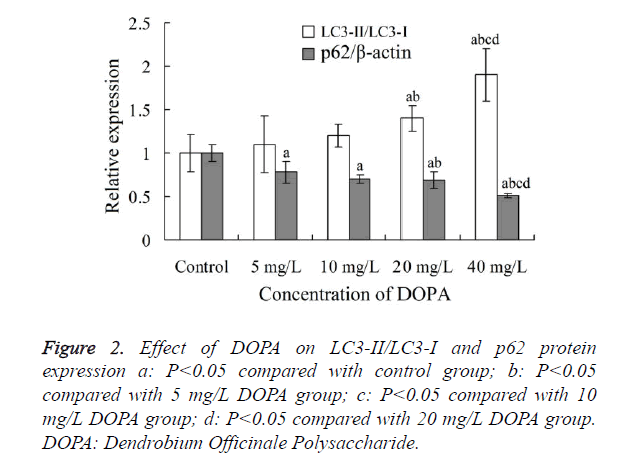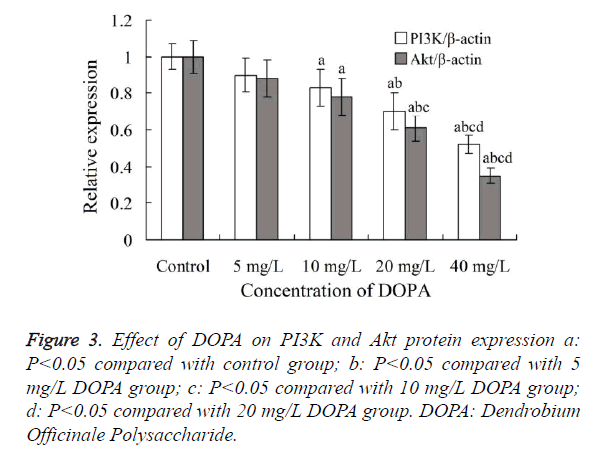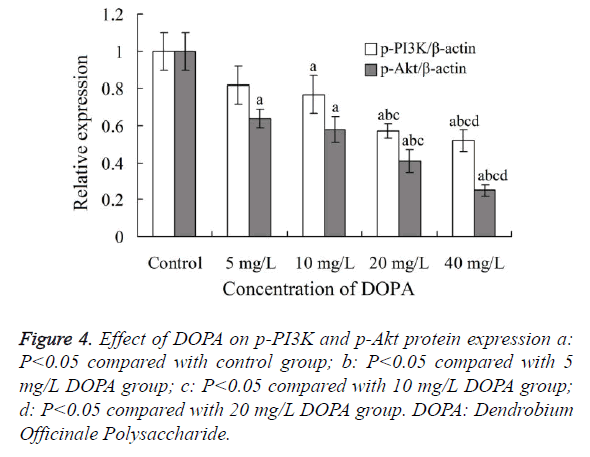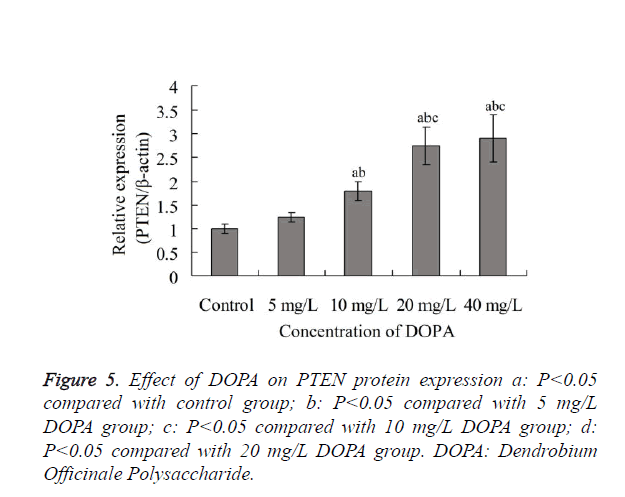ISSN: 0970-938X (Print) | 0976-1683 (Electronic)
Biomedical Research
An International Journal of Medical Sciences
Research Article - Biomedical Research (2017) Volume 28, Issue 4
Inhibitory effect of Dendrobium officinale polysaccharide on growth of human breast cancer MCF-7 cells and the related mechanism
1Department of Breast and Thyroid Surgery, Renmin Hospital of Wuhan University, China
2Department of Clinical Laboratory Medicine Centre, Renmin Hospital of Wuhan University, China
3Department of Breast, Thyroid, Hernia and Vascular Surgery, Inner Mongolia People’s Hospital, China
- *Corresponding Author:
- Sun Shengrong
Department of Breast and Thyroid Surgery
Renmin Hospital of Wuhan University, China
Accepted on October 5, 2016
This study aims to investigate the inhibitory effect of Dendrobium Officinale Polysaccharide (DOPA) on growth of human breast cancer MCF-7 cells and the related mechanism. Human breast cancer MCF-7 cells were cultured and passaged. The cells were treated with DOPA with concentration of 5, 10, 20 and 40 mg/L. The cell activity was detected using MTT method, and the cell growth inhibition rate was calculated. The cell cycle and apoptosis were detected by flow cytometry. The protein expressions of LC3, p62, PI3K, Akt, p-PI3K, p-Akt and PTEN in cells were determined using Western blot assay. Results showed that, after treatment with DOPA, the growth of MCF-7 cells was obviously inhibited. When the treatment time was 48 h, the inhibition rate in 40 mg/L DOPA group was the highest, which was 35.43 ± 4.36%. The cell cycle was arrested in the G1 phase and S phase, and the total cell apoptosis rate in 40 mg/L DOPA group was 33.56 ± 4.02%. After treatment with DOPA, compared with control group, the protein expression levels of LC3-II and PTEN were significantly increased (P<0.05), and those of LC3-I, p62, PI3K, Akt, p-PI3K and p-Akt were significantly decreased (P<0.05). DOPA can inhibit the growth of human breast cancer MCF-7 cells. The mechanism may be related to its inhibition of PTEN/PI3K/Akt signaling pathway.
Keywords
Dendrobium officinale, Polysaccharide, MCF-7, Growth.
Introduction
Polysaccharide is a kind of natural active substance which exists in plants, animals and microorganisms. Polysaccharide has pharmacological effects such as regulating immunity [1], anti-tumour [2] and anti-oxidation [3], and polysaccharide from different sources has different biological activities. At present, many kinds of polysaccharide have been successfully extracted from a large number of plants, and are widely used in the research and development of medicines and health foods. Dendrobium officinale is a member of Orchidales Dendrobium plants, and is one of the precious Chinese herbal medicines contained in Pharmacopoeia of the People's Republic of China [4]. In traditional Chinese medicine, Dendrobium officinale has the effect of nourishing yin and clearing heat, reinforcing stomach fluid, and moistening lung for arresting cough [5]. Pharmacology and phytochemistry show that, the polysaccharide compounds are the main biological active substances in Dendrobium officinale, with high content [6]. In recent years, the research of Dendrobium Officinale Polysaccharide (DOPA) has gradually attracted the attention of many people. DOPA has the effects such as antioxidant [7] and enhancing immunity [8]. Study has shown that, DOPA has inhibitory effect on mice liver cancer H22 cells, and human cervical carcinoma HeLaS3 cells and HepG2 cells [9], but its effect on human breast cancer cells has not been reported. This study investigated the inhibitory effect of DOPA on growth of human breast cancer MCF-7 cells, and analysed the possible mechanism. The objective was to provide an experimental basis to further application of DOPA in treatment of human breast cancer.
Materials and Methods
The whole plant of Dendrobium officinale was purchased from Yunnan Kim Gu Biological Technology Co., Ltd. (Kunming, China). Breast cancer MCF-7 cells were purchased from Typical Culture Preservation Committee Cell Bank of Chinese Academy of Sciences (Beijing, China). The antibodies related to LC3, p62, PI3K, Akt, p-PI3K, p-Akt and PTEN were provided by Shanghai Sangon Biological Engineering Technology & Services Co., Ltd. (Shanghai, China). RPMI-1640 culture medium, FBS and other reagents were purchased from Sigma-Aldrich Corp. (MO, USA).
Extraction of DOPA
Dendrobium officinale stem was washed. After drying at 60°C for 4 h, it was smashed. The water extracting and alcohol precipitating method was used to extract the polysaccharide. After deproteinization using trichloroacetic acid, centrifugation, and precipitation and drying under vacuum condition, the crude polysaccharide was obtained. The ethanol was added to the crude polysaccharide, and the alcohol concentration was adjusted to 40%. The precipitation was collected. Then the alcohol concentration was adjusted to 70%, and the precipitation was collected. Finally, the supernatant was adjusted to 90%, and the precipitation was collected. After freeze-drying, and the final polysaccharide product was obtained. The sulphuric acid-phenol method [10] showed the content of polysaccharide was 80%.
Culture of human breast cancer MCF-7 cells
MCF-7 cells were cultured with RPMI-1640 medium containing 10% FBS (37°C, 5% CO2). The streptomycin and penicillin were added to the culture medium, with final concentration of 100 mg/L, followed by cell adherent growth for 24 h. The cell passage was performed when the cells reached the logarithmic growth phase.
Detection of cell activity
MTT method was used to detect the activity of MCF-7 cells. The cells in the logarithmic growth phase with concentration of 1 × 105 cell/ml were incubated in 96-well culture plate, 100 μL per well. After 24 h the original medium was removed. The cells were divided into 5 groups, 5 wells in each group. In experimental groups, the DOPA was added to the well, and the culture medium was added to make the final volume 200 μL. The final DOPA concentration was 5, 10, 20 and 40 mg/L, respectively. In the control group, 0.1% DMSO solution was added to make the final volume 200 μL). After culture (37°C, 5% CO2) for 6, 24 and 48 h, the culture medium was sucked and 20 μL MTT was added to each well, followed by culture for 4 h. The supernatant was discarded. 100 μL DMSO was added to each well, followed by oscillation for 5 min. The Optical Density (OD) of cell solution was detected using Multiskan FC microplate reader (Thermo Fisher Scientific, Inc., MA, USA) at the wavelength of 570 nm. The cell growth inhibition rate was calculated as follows: cell growth inhibition rate=(ODcontrol group-ODexperimental group)/ODcontrol group × 100%. The detection was repeated for 3 times, and the average value was obtained.
Detection of cell apoptosis and cell cycle
The cycle and apoptosis of MCF-7 cells were detected by flow cytometry assay. After treatment with DOPA for 48 h, the culture medium was sucked off, followed by centrifugation at 2000 r/min for 10 min. The cells were washed with PBS for 3 times. 1 mL of propidium iodide and 1 mL of RNA enzyme without DNA enzyme contamination were added, with final concentration of 50 μg/mL. After dyeing for 0.5-1 h, the cell apoptosis and cell cycle were measured using FACSCanto II flow cytometer (Becton, Dickinson and Company, NJ, USA).
Detection of protein expressions of LC3, p62, PI3K, Akt, p-PI3K, p-Akt and PTEN
After treatment with DOPA for 48 h, the culture medium was sucked. The cells were collected, lysed, and centrifuged. The supernatant was obtained and the protein concentration was measured using the bicinchoninic acid method. The expressions of LC3-I, LC3-II, p62, PI3K, Akt, p-PI3K, p-Akt and PTEN protein were determined using Western blotting assay according to the instructions of kits.
Statistical analysis
Data are presented as mean ± SD. Statistical analysis was performed using the SPSS 17.0 statistical software. The independent-sample Student t-test was used to analyse the differences between the two groups. P<0.05 was considered to be statistically significant.
Results
Effect of DOPA on the growth of MCF-7 cells
After treatment for 6, 24 and 48 h, 5, 10, 20 and 40 mg/L DOPA could inhibit the proliferation of MCF-7 cells. The inhibition rate increased with the increase of the concentration of DOPA or prolonging of treatment time. When the treatment time was 48 h, the inhibition rate of 40 mg/L DOPA group was the highest, which was 35.43 ± 4.36%. When the concentration was 5, 10 and 20 mg/L, DOPA showed a relatively weak inhibitory effect on the proliferation of MCF-7 cells (Table 1).
| Time | Inhibition rate (%) | ||
|---|---|---|---|
| 6 h | 24 h | 48 h | |
| 5 mg/L DOPA | 0.45 ± 0.11 | 0.78 ± 0.09 | 0.97 ± 0.12 |
| 10 mg/L DOPA | 4.44 ± 0.56a | 7.87 ± 0.78a | 12.45 ± 1.23a |
| 20 mg/L DOPA | 8.31 ± 1.02ab | 13.21 ± 2.02ab | 20.12 ± 3.82ab |
| 40 mg/L DOPA | 12.23 ± 1.88abc | 17.22 ± 2.03abc | 35.43 ± 4.36abc |
| a: P<0.05 compared with 5 mg/L DOPA group; b: P<0.05 compared with 10 mg/L DOPA group; c: P<0.05 compared with 20 mg/L DOPA group. DOPA: Dendrobium Officinale Polysaccharide. | |||
Table 1. Effect of DOPA on the growth of MCF-7 cells.
Effect of DOPA on cycle and apoptosis of MCF-7 cells
After 48 h of culture, most of the MCF-7 cells in the control group were in the G1 phase and S phase, and the cells in the G2-M phase were the least. The total apoptosis rate of MCF-7 cells was 1.45 ± 0.23%. The cells treated with DOPA appeared the sub-G0-G1 phase which indicated the apoptosis. The apoptosis rate increased with the increase of DOPA concentration. After treatment with 5, 10, 20 and 40 mg/L DOPA, the total cell apoptosis rate was 5.05 ± 0.67%, 12.44 ± 1.44%, 26.12 ± 3.21% and 33.56 ± 4.02%, respectively (Figure 1). These results indicated that DOPA could arrest the cycle of MCF-7 cells, and induce the apoptosis.
Effect of DOPA on LC3-II and p62 protein expression
Results of blot Western assay showed that, after treating for 48 h, with the increase of DOPA concentration, the level of autophagy marker protein LC3-II increased, and that of LC3-I decreased, with increased LC3-II/LC3-I ratio. In addition, the level of p62 protein decreased. All of them had a dosedependent manner. The effect of 40 mg/L DOPA was the most obvious (Figure 2). This indicated that DOP could not only induce the apoptosis of MCF-7 cells, but also induce the cell autophagy.
Effect of DOPA on PI3K and Akt protein expression
After treating for 48 h, with the increase of DOPA concentration, the level of PI3K and Akt protein decreased, with a dose-dependent manner. The decreasing effect of 40 mg/L DOPA was the most obvious, and the PI3K/actin and Akt/actin ratios were 0.52 ± 0.05 and 0.35 ± 0.04, respectively (Figure 3).
Effect of DOP on the p-PI3K and p-Akt protein expression
As shown in Figure 4, the p-PI3K and p-Akt levels decreased with the increase DOPA concentration, with a dose-dependent manner. When the DOPA concentration was 40 mg/L, the p- PI3K/actin and p-Akt/actin values were 0.52 ± 0.06 and 0.25 ± 0.03, respectively, which were significantly lower than control group (P<0.05).
Effect of DOP on the expression of PTEN protein expression
Figure 5 showed that, the PTEN levels increased with the increase DOPA concentration, with a dose-dependent manner. When the DOPA concentration was 40 mg/L, the PTEN/β-actin value was 2.91 ± 0.51, which was significantly higher than control group (P<0.05).
Discussion
Breast cancer is one of the most common malignant tumours which threaten the health of women. Its pathogenesis and treatment have been an important issue to be solved urgently [11]. After many years of research, an effective means of treatment has not yet been found. The traditional Chinese medicine has the advantages of multi-pathway, multi-target and low toxic effect. The use of traditional Chinese medicine to prevent and cure cancer is more and more favoured by the majority of clinicians and patients [12,13]. Seeking anti-breast cancer drugs from traditional Chinese medicine has become one of the hot research topics. At present, natural medicines play an important role in the process of tumour therapy. In recent years, more and more monomeric compounds in natural medicines have been proved to have good anti-tumour effect, such as paclitaxel and so on [14]. Therefore, it is very important to find the action target of natural medicines and the signal transduction mechanism for the treatment of cancer and the development of natural medicines. Dendrobium plants have obvious anti-tumour effect. He et al. [15] have studied the relationship between the inhibition effect and the dose of DOPA for mouse hepatoma H22 cells. Results show that, 50 mg/kg DOPA has significant inhibitory effect on the growth of H22 cells, and the inhibition rate was 28.6%. Bao et al. [9] have compared the inhibition effect of water extracts from 4 kinds of Dendrobium on human cervical cancer HelaS3 cells and human hepatoma HepG2 cells. Results show that, all the water extracts from Dendrobium huoshanense, Dendrobium officinale, Dendrobium nobile and Dendrobium fimbriatum have different degree of inhibition effect on human cervical carcinoma of HeLaS3 and HepG2 cells. The extract from Dendrobium fimbriatum has the best inhibitory effect on HelaS3 cells, and that from Dendrobium nobile has the best inhibitory effect on HepG2 cells. This study investigates the inhibitory effects of DOPA on breast cancer MCF-7 cells. It is found that DOPA can obviously inhibit the growth of MCF-7 cells, and promote the cell apoptosis. Autophagy is process in which the cells form autophagosomes through the bilayer membrane wrapping pending-degradation products, and then the autophagosomes are transported to the lysosomes to form the autophagic lysosomes. This can decompose the wrapped contents, achieving the metabolism of cell itself and updating of organelle. Under the condition of chemotherapy, starvation and hypoxia, the occurrence of autophagy can be activated, and the autophagy is closely related to apoptosis [16]. Recent study has shown that, some chemotherapeutic drugs such as erythromycin can not only induce the apoptosis of tumour cells, but also activate the autophagy [17]. The role of autophagy is a double-edged sword for tumour cells. On the one hand, the autophagy inhibits the growth of tumour cells; on the other hand, it promotes the survival of tumour cells, eventually leading to the resistance of tumour cells to chemotherapy drugs [18]. LC3 and p62 are two marker proteins related to autophagy. When autophagy occurs, LC3 is transformed from cytosolic type LC3-I to the autophgosomemembrane type LC3- II. At the same time, p62 is degraded [19]. The results of this study show that, after DOPA treatment, the LC3-II/LC3-I ratio increases, and the expression of p62 decreases. This indicates that, DOPA can promote the autophagy of MCF-7 cells. The signalling pathway composed by PI3K and its downstream molecule Akt is involved in the occurrence and development of tumours, and can regulate the proliferation and survival of tumour cells. The abnormal activity of this pathway not only leads to malignant transformation, but also is closely related to tumour cell migration, adhesion, angiogenesis and degradation of extracellular matrix [20]. Inhibition of this pathway can inhibit tumour cell proliferation and promote the cell apoptosis. On the contrary, activating this pathway has the function of promoting cell proliferation [21]. Results of this study showed that, after treating with DOPA, the levels of PI3K and Akt and their phosphorylation levels (p-PI3K and p-Akt) in MCF-7 cells were significantly decreased. This indicates that, the inhibition of DOPA on MCF-7 cells is correlated with its inhibition of PI3K/Akt signalling pathway. PTEN is the PIP3- phosphatase, which has the function opposite to PI3K. It can transform PIP3 into PI-4 and 5-P2 by the phosphorylation, and reduces the activation of Akt, thus preventing the downstream signal transduction regulated by Akt. PTEN is a key factor in the PI3K/Akt signal pathway [22]. Results of this study showed that, after DOPA treatment, the PTEN protein expression in MCF-7 cells was significantly increased. This indicates that, the inhibition of DOPA on MCF-7 cells may be related to its promotion of PTEN protein expression.
In conclusion, DOPA can inhibit the growth of human breast cancer MCF-7 cells. The possible mechanism may be that, DOPA up-regulates the LC3-II expression, down-regulates the LC3-I expression and p62 expression. In addition, DOPA inhibits the expression of PI3K and Akt and their phosphorylation, and promotes the expression of PTEN. The results of this study have provided an experimental basis for further investigating the inhibitory effects of DOPA on the growth of human breast cancer MCF-7 cells and the possible molecular mechanism, and further widening the application of DOPA to treatment of human breast cancer. Of course, whether there are other mechanisms of DOPA action and whether there are correlations among the present signalling pathways need to be further investigated.
References
- Liu QY, Yao YM, Zhang SW, Sheng ZY. Astragalus polysaccharides regulate T cell-mediated immunity via CD11c(high)CD45RB(low) DCs in vitro. J Ethnopharmacol 2011; 136: 457-464.
- Fan Y, Wang W, Song W, Chen H, Teng A, Liu A. Partial characterization and anti-tumor activity of an acidic polysaccharide from Gracilaria lemaneiformis. Carbohydr Polym; 88: 1313-1318.
- Zhang J, Yu Y, Zhang Z, Ding Y, Dai X, Li Y. Effect of polysaccharide from cultured Cordyceps sinensis on immune function and anti-oxidation activity of mice exposed to 60Co. Int Immunopharmacol 2011; 11: 2251-2257.
- Li X, Ding X, Chu B, Zhou Q, Ding G, Gu S. Genetic diversity analysis and conservation of the endangered Chinese endemic herb Dendrobium officinale Kimura et Migo (Orchidaceae) based on AFLP. Genetica 2008; 133: 159-166.
- Xiang L, Sze CWS, Tong Y, Zhang Z, Feng Y, Chen JP, Ng TB, Lin X, Shaw PC, Zhang KY. Protective effect of Dendrobium officinale polysaccharides on experimental Sjogren's syndrome. J Compl Integr Med 2010; 7: preceding 1.
- Huang K, Li Y, Tao S, Wei G, Huang Y, Chen D, Wu C. Purification, characterization and biological activity of polysaccharides from Dendrobium officinale. Molecules 2016; 21: E701.
- Luo QL, Tang ZH, Zhang XF, Zhong YH, Yao SZ, Wang LS, Lin CW, Luo X. Chemical properties and antioxidant activity of a water-soluble polysaccharide from Dendrobium officinale. Int J Biol Macromol 2016; 89: 219-227.
- Liu XF, Zhu J, Ge SY, Xia LJ, Yang HY, Qian YT, Ren FZ. Orally administered Dendrobium officinale and its polysaccharides enhance immune functions in BALB/c mice. Nat Prod Commun 2011; 6: 867-870.
- Bao LJ. Inhibitory effects of water extracts from four species of Dendrobiums on HelaS3 cells and HepG2 cells. J Anhui Agri Sci 2008; 36: 15968-15970.
- Saha SK, Brewer CF. Determination of the concentrations of oligosaccharides, complex type carbohydrates, and glycoproteins using the phenol-sulfuric acid method. Carbohydr Res 1994; 254: 157-167.
- Lasa A, Garcia A, Alonso C, Millet P, Cornet M, Ramón y Cajal T, Baiget M, Barnadas A. Molecular detection of peripheral blood breast cancer mRNA transcripts as a surrogate biomarker for circulating tumour cells. PLoS One 2013; 8: e74079.
- Li X, Wu L, Liu W, Jin Y, Chen Q, Wang L, Fan X, Li Z, Cheng Y. A network pharmacology study of Chinese medicine Qi Shen Yi Qi to reveal its underlying multi-compound, multi-target, multi-pathway mode of action. PLoS One 2014; 9: e95004.
- Zhang DZ. Effects of traditional Chinese medicine and pharmacology on increasing sensitivity and reducing toxicity in tumor patients undergoing radio-chemical therapy. Zhong Guo Zhong Xi Yi Jie He Za Zhi 1992; 12: 135-138.
- Xu Q, Liu Y, Su S, Li W, Chen C, Wu Y. Anti-tumour activity of paclitaxel through dual-targeting carrier of cyclic RGD and transferrin conjugated hyperbranched copolymer nanoparticles. Biomaterials 2012; 33: 1627-1639.
- He TG, Yang LT, Li YR, Wang CQ, Huang DP. Physicochemical properties and antitumour activity of polysaccharide DCPP1a-1 from suspension-cultured protocorms of Dendrobium candidum. Tian Ran Chan Wu Yan Jiu Yu Kai Fa 2007; 19: 578-583.
- White E, Mehnert JM, Chan CS. Autophagy, Metabolism, and Cancer. Clin Cancer Res 2015; 21: 5037-5046.
- Han W, Sun J, Feng L, Wang K, Li D, Pan Q, Chen Y, Jin W, Wang X, Pan H, Jin H. Autophagy inhibition enhances daunorubicin-induced apoptosis in K562 cells. PLoS One 2011; 6: e28491.
- Kubisch J, Türei D, Földvári-Nagy L, Dunai ZA, Zsákai L, Varga M, Vellai T, Csermely P, Korcsmáros T. Complex regulation of autophagy in cancer-integrated approaches to discover the networks that hold a double-edged sword. Semin Cancer Biol 2013; 23: 252-261.
- Daniels BH, McComb RD, Mobley BC, Gultekin SH, Lee HS, Margeta M. LC3 and p62 as diagnostic markers of drug-induced autophagic vacuolar cardiomyopathy: a study of 3 cases. Am J Surg Pathol 2013; 37: 1014-1021.
- Chang F, Lee JT, Navolanic PM, Steelman LS, Shelton JG, Blalock WL, Franklin RA, McCubrey JA. Involvement of PI3K/Akt pathway in cell cycle progression, apoptosis, and neoplastic transformation: a target for cancer chemotherapy. Leukemia 2003; 17: 590-603.
- Zhuo B, Li Y, Li Z, Qin H, Sun Q, Zhang F, Shen Y, Shi Y, Wang R. PI3K/Akt signaling mediated Hexokinase-2 expression inhibits cell apoptosis and promotes tumour growth in pediatric osteosarcoma. Biochem Bioph Res Co 2015; 464: 401-406.
- Kang NI, Yoon HY, Kim HA, Kim KJ, Han MK, Lee YR, Hwang PH, Soh BY, Shin SJ, Im SY, Lee HK. Protein kinase CK2/PTEN pathway plays a key role in platelet-activating factor-mediated murine anaphylactic shock. J Immunol 2011; 186: 6625-6632.




